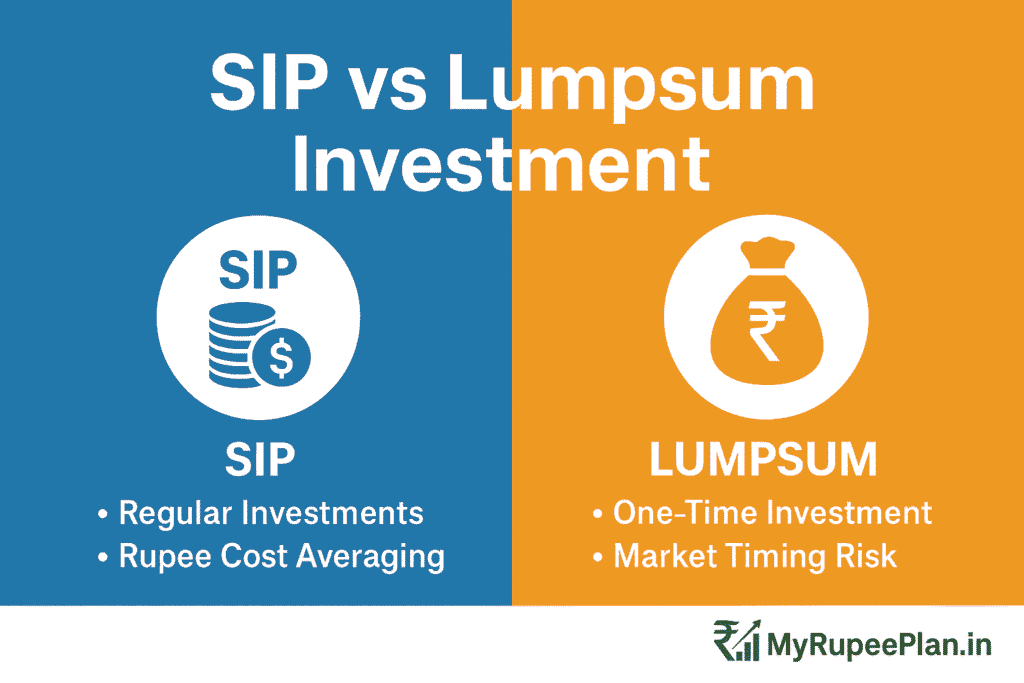SIP vs Lumpsum Investment: Which Strategy Works Best for You?
Introduction
Choosing between SIP vs Lumpsum investment can be confusing for many Indian investors. If you’re planning to grow your wealth through mutual funds, knowing the difference between these strategies is crucial. Each has its strengths, and the right choice depends on your financial situation, market outlook, and risk tolerance.

What is SIP (Systematic Investment Plan)?
A Systematic Investment Plan (SIP) allows you to invest a fixed amount regularly—usually monthly—into mutual funds. It promotes disciplined investing and helps in rupee cost averaging.
Key Features of SIP:
- Fixed monthly investment
- Ideal for salaried individuals
- Reduces timing risk
- Long-term wealth creation
- Flexible investment amount
What is Lumpsum Investment?
Lumpsum investment refers to investing a large amount of money at once. It’s typically done when an investor has surplus funds and wants to invest in a single transaction.
Key Features of SIP:
- One-time investment
- Suitable during market dips
- Requires timing the market
- Can lead to higher returns in bull runs
- Works better for experienced investors
What is Lumpsum Investment?
| Factor | SIP | Lumpsum |
|---|---|---|
| Investment Style | Regular monthly | One-time |
| Risk Management | Lower due to rupee cost averaging | Higher due to timing risk |
| Ideal For | Salaried or first-time investors | Investors with surplus funds |
| Market Timing | Not required | Crucial |
| Financial Discipline | Encourages saving habit | Requires fund availability |
| Return Potential | Steady over long term | Higher if timed correctly |
Case Study: ₹5,000 SIP vs ₹60,000 Lumpsum
Let’s assume both investments are made in a mutual fund giving 12% annual returns:
| Strategy | Duration | Total Invested | Value After 1 Year | Value After 5 Years |
|---|---|---|---|---|
| SIP (₹5,000/month) | 12 months | ₹60,000 | ₹63,300 | ₹3.9 Lakhs |
| Lumpsum (₹60,000) | Once | ₹60,000 | ₹67,200 | ₹1.06 Lakhs |
📊 Observation: Over the short term, lumpsum performs slightly better, but over long periods, SIPs grow substantially due to compounding and regular investment discipline.
When to Choose SIP?
- You have a regular income (salary)
- Want to build wealth gradually
- Prefer lower risk
- Uncertain about market timing
- Starting with small capital
When to Choose Lumpsum?
- Received bonus, inheritance, or windfall
- Confident about market valuation (e.g., after a market crash)
- Prefer active investing approach
- Ready to accept higher short-term risk
Tax Considerations
- Both SIP and lumpsum in Equity Mutual Funds enjoy long-term capital gains tax exemption up to ₹1 lakh/year after 1 year.
- Debt Mutual Funds (post new rules) are taxed based on income tax slab irrespective of holding period.
Expert Opinion
Many financial planners recommend SIP for average investors due to its simplicity and psychological comfort. Lumpsum is often suited for those who can ride market volatility and have a high risk appetite.
Final Verdict: SIP or Lumpsum?
| Scenario | Recommended Strategy |
|---|---|
| Monthly salaried professional | SIP |
| Large bonus or windfall | Lumpsum |
| Market at all-time high | SIP |
| Market correction or crash | Lumpsum |
| New to investing | SIP |
| Experienced investor | Either (based on goal) |
Conclusion
Both SIP and lumpsum have their pros and cons. The best strategy depends on your financial goals, investment horizon, and risk tolerance. You can even combine both: use SIP for regular investing and deploy lumpsum during market corrections.
Frequently Asked Questions (FAQs)
Q1. Which gives better returns – SIP or Lumpsum?
Lumpsum can offer better returns if invested at the right time. SIP offers steady long-term returns and reduces timing risk.
Q2. Can I switch from SIP to Lumpsum later?
Yes. You can pause SIPs and make lumpsum investments if you have extra funds.
Q3. Is SIP safer than Lumpsum?
Generally, yes. SIPs smoothen out volatility and average your investment cost.
Q4. Can I do SIP and Lumpsum in the same fund?
Absolutely. Many investors combine both approaches for balance.
Q5. What is the minimum amount for SIP and Lumpsum?
Most mutual funds allow SIPs starting at ₹500/month and lumpsum from ₹1,000 onwards.
